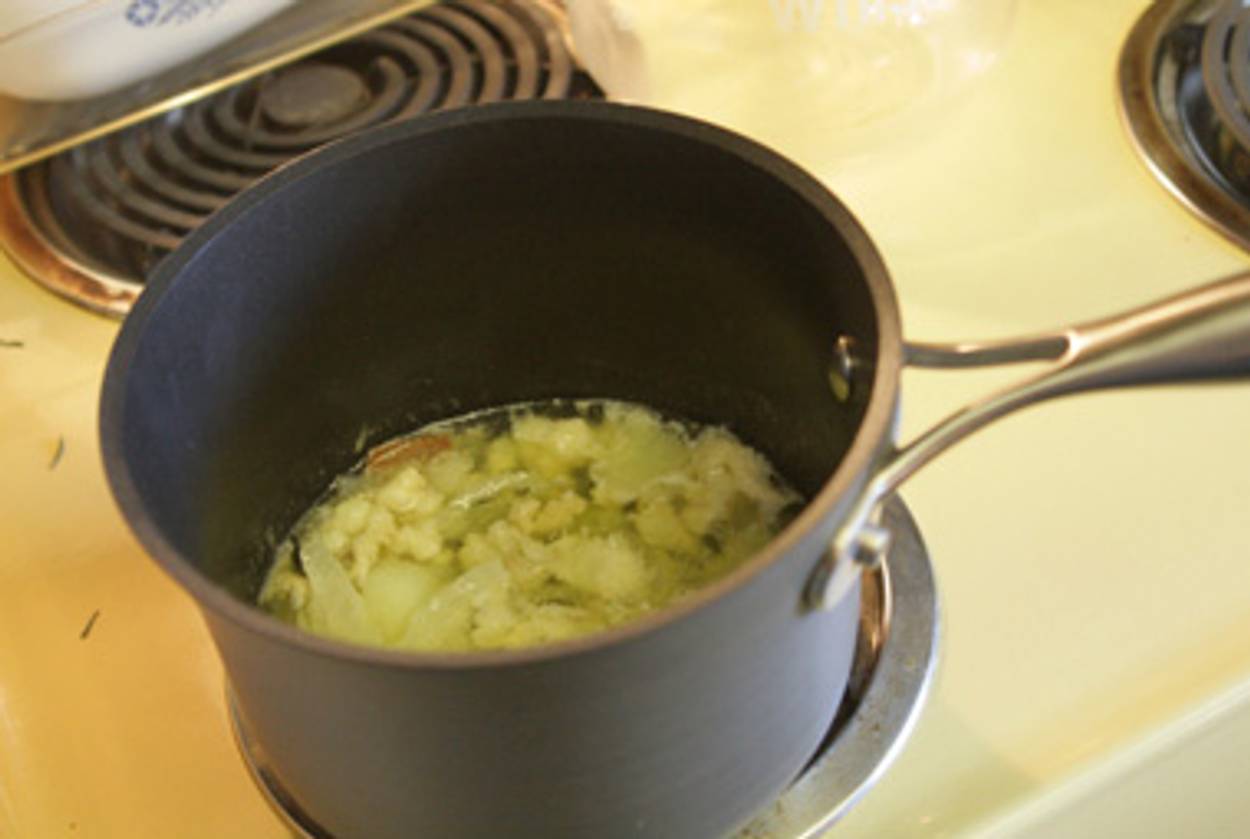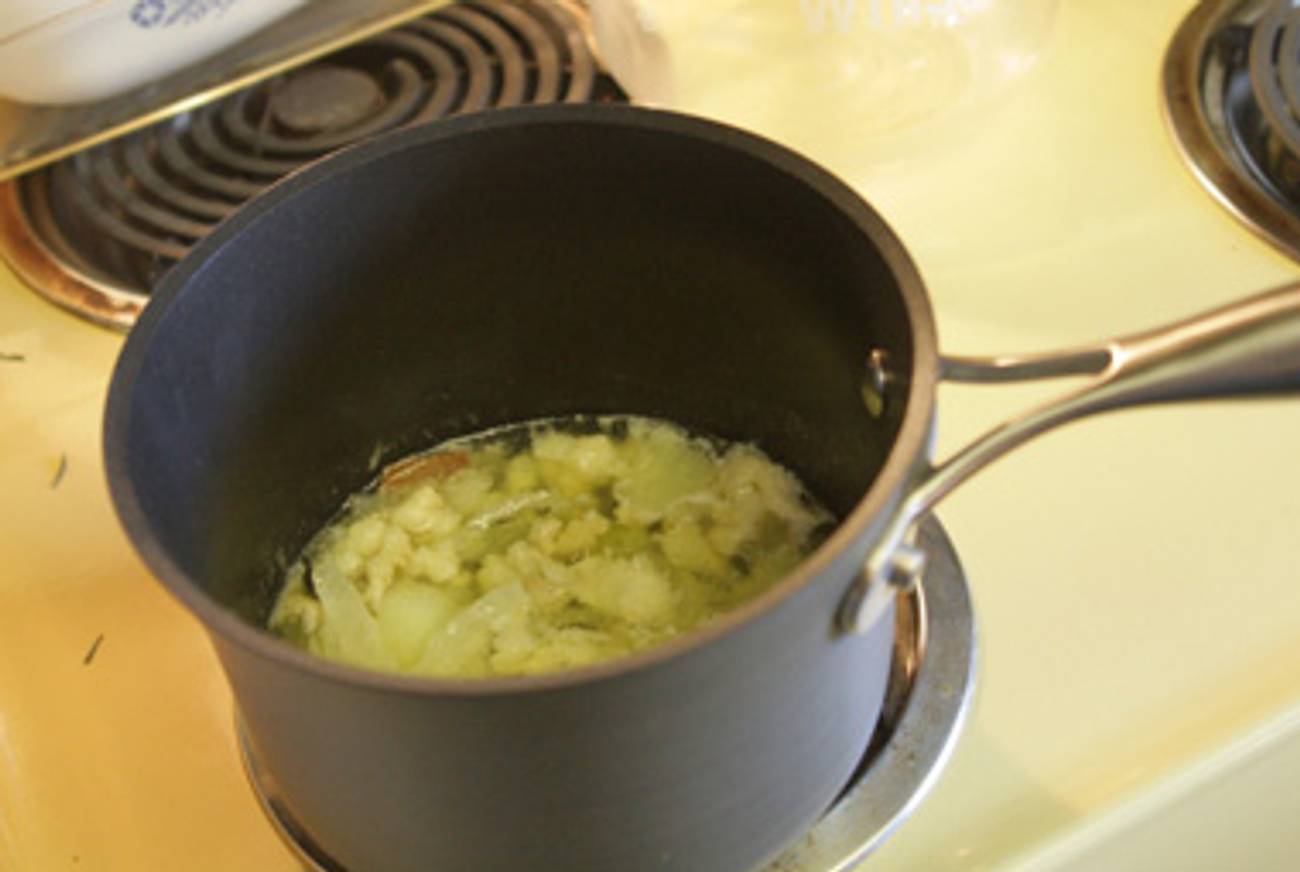Fat Camp
Once a staple but long out of fashion, schmaltz makes a comeback




On a rainy fall night in Teaneck, New Jersey, Rabbi Rachel Kahn-Troster and her husband bumped around their tiny kitchen, tending a heavy skillet full of frying potatoes and onions. Kahn-Troster, 30, spooned a pudding-like yellow glop into the pan, where it sizzled and gave off the aroma of a highly concentrated chicken soup.
She was cooking with homemade schmaltz, an ingredient she discovered by accident a year earlier while following a Mark Bittman recipe for duck breast that left her with a jar of liquefied fat. Nowadays she keeps a plastic bag of chicken skin and fat in her freezer ready for rendering at a moment’s notice. “When we got married, Paul and I joked that we both like old Jewish man food,” Kahn-Troster said. “If it’s kosher we’re kind of willing to try it.”
Schmaltz—the result of the long process of heating leftover chicken fat with chopped onions over a low flame until it liquefies—was once suspected to be on an irreversible decline. Health concerns, the advent of margarine after World War II, and a desire to assimilate exiled it from most Jewish kitchens. But now a new generation of Jewish and gentile cooks are rediscovering the old staple.
“Sometimes I get a chicken and it’s very fatty, and I pull of the fat and throw it in the freezer. And when I have some time I render it,” said Tina Ujlaki, a non-Jew and food editor at Food & Wine Magazine who doesn’t like to waste any part of of the animal. She fries onions and chicken skin in schmaltz, a concoction known as gribenes, for a topping. “You can sprinkle them on top of liver, on top of salad, or just sort of use them like you would a crouton,” she said. “Chicken cracklings would be awesome. Not that potatoes fried in chicken fat wouldn’t be amazing.”
Once an essential part of the “yiddishe tam,” or Jewish taste, schmaltz was, according to New York University culinary ethnographer Eve Jochnowitz, part heritage, part economy. It was poor food, made and used by Jewish cooks trying to stretch every piece of chicken for maximum nutrition and served as a spread akin to butter and often eaten with grated radish. But like many other traditional food practices, its popularity ebbed.
Even among slow food devotees.“It’s not the way people cook anymore,” Jochnowitz said. “The days when you got up early in the morning and started cooking—those days just really are gone.”
What’s more, schmaltz suffered from various stigmas. Susan Rosenthal, a 59-year-old doctor in East Brunswick, New Jersey, said that although she grew up eating her grandmother’s schmaltz, her mother never served it. “In my mother’s generation, people who grew up wanted to be American. People changed their names then, nose jobs were really big. And part of being modern was eating American food,” she said.
Yet though beaten, schmaltz was far from dead, as the Empire Kosher Chicken company discovered in early 2007, when CEO Greg Rosenbaum discontinued packaged schmaltz to cut costs on what he saw as an unprofitable product. His aunt and her sisterhood swamped his phone line with calls of protest and by Passover schmaltz was back on grocery shelves, according to Empire spokesman Elie Rosenfeld. It’s high sales points are just before Passover, Rosh Hashanah, and Hanukkah.
If Empire’s schmaltz caters to devoted older customers, there are recent signs that younger, trendier cooks have similarly become schmaltz champions. Mitch Davis, the vice president of the James Beard Foundation, featured schmaltz prominently on his book tour for The Mensch Chef cookbook in 2002. “At all the events that had food, I served as appetizers gribenes cooked until they were crisp, and topped with sea salt,” Davis said. “People ate them like they’d never eaten before.” Then, last September, Ten Speed Press published Jennifer McLagan’s Fat: An Appreciation of a Misunderstood Ingredient, with Recipes. A month later, Mark Bittman, the Minimalist food columnist for the The New York Times, featured schmaltz as an essential ingredient in an article and related video about preparing kasha varnishkes.
Beyond the taste, schmaltz connects to sustainable eating. Kahn-Troster said that cooking with schmaltz meshes with her attempt to keep a low ecological profile. She and her husband drive Priuses, and for every Talmud volume on her shelves, there is a food politics book by Marion Nestle or Michael Pollan. “Meat comes from a real animal and we need to respect that animal,” she said. “The more and more parts of the animal we throw away the less respectful we are.”
Schmaltz also has, improbably, gotten a clean bill of health. According to NYU’s Jochnowitz, a vegetarian, schmaltz has less trans fat than margarine and more omega-3 fatty acids than most vegetable oils. That means it’s better for the heart and brain.
David Sax, whose book Save the Deli comes out later this month, noted that a schmaltz revival would be on par with wider trends in the American kitchen. “The fat-phobia that hit the delis and got a lot of them to replace schmaltz with vegetable oil in chopped liver and kishke [stuffed derma], that sort of peaked in the ’80s to the ’90s,” he said. “If you see in non-Jewish, goyish food culture, fat is really the battle of the moment, the biggest thing is the fattiest part of the pork.”
Despite its ups and downs in Jewish American history, schmaltz, said Sax, “stays in your body forever.”
Daniella Cheslow is a freelance writer living in Israel.
Daniella Cheslow is an American journalist covering the Middle East.